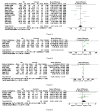The Prevalence of Hypogonadism and the Effectiveness of Androgen Administration on Body Composition in HIV-Infected Men: A Meta-Analysis
- PMID: 34440836
- PMCID: PMC8392149
- DOI: 10.3390/cells10082067
The Prevalence of Hypogonadism and the Effectiveness of Androgen Administration on Body Composition in HIV-Infected Men: A Meta-Analysis
Abstract
Background: Hypogonadism is a common comorbidity in human immunodeficiency virus (HIV)-infected men, although the real prevalence is difficult to be estimated. Moreover, in HIV settings, the efficacy of exogenous testosterone (Te) administration at improving body composition remains unclear.
Aim of the study: This review has a double aim. First, to estimate the prevalence of pituitary-testis axis abnormality in HIV-infected patients compared to uninfected subjects. Second, to evaluate the effect of androgen administration on body composition in HIV-infected men.
Materials and methods: A systematic review of the literature and meta-analysis was carried out. Two separated literature searches were performed, the first to evaluate the prevalence of Te deficiency in HIV-infected men and the second one to evaluate effects of androgen administration on body composition.
Results: The overall prevalence of Te deficiency in HIV-infected men was calculated from 41 studies, showing a 26% prevalence, which was even higher when free T (fT) levels, more than total T, were considered. Indeed, TT serum levels were similar between HIV patients and controls, although higher SHBG and lower fT were detected in HIV populations. When HIV-infected men were treated with exogenous Te, a significant increase in body weight, lean body mass and fat free mass was detected.
Conclusion: The systematic review confirms the high prevalence of Te deficiency in HIV-infected men, particularly when fT has been considered. Moreover, chronic androgen supplementation improves body composition, affecting the lean mass compartment. However, considering the general frailty of HIV patients, a tailored indication for Te therapy should be advocated.
Keywords: HIV; androgen replacement treatment; body composition; hypogonadism; testosterone.
Conflict of interest statement
The authors declare that the research was conducted in the absence of any commercial or financial relationships that could be construed as a potential conflict of interest.
Figures









References
-
- De Vincentis S., Decaroli M.C., Fanelli F., Diazzi C., Mezzullo M., Morini F., Bertani D., Milic J., Carli F., Cuomo G., et al. Health status is related to testosterone, estrone and body fat: Moving to functional hypogonadism in adult men with HIV. Eur. J. Endocrinol. 2021;184:107–122. doi: 10.1530/EJE-20-0855. - DOI - PubMed
Publication types
MeSH terms
Substances
LinkOut - more resources
Full Text Sources
Medical
Research Materials
Miscellaneous

